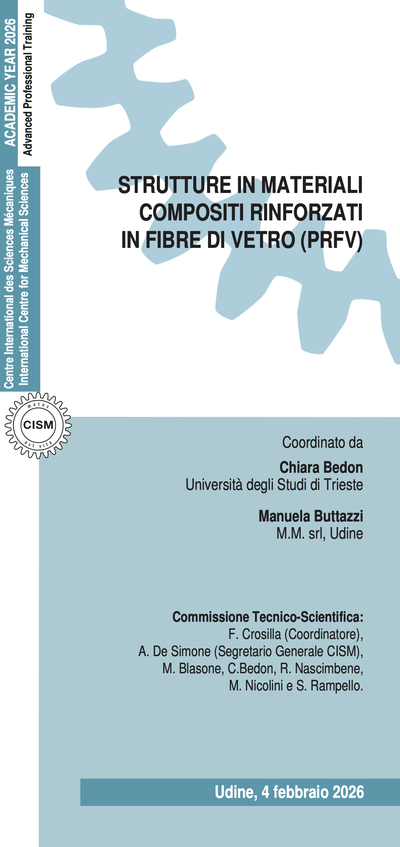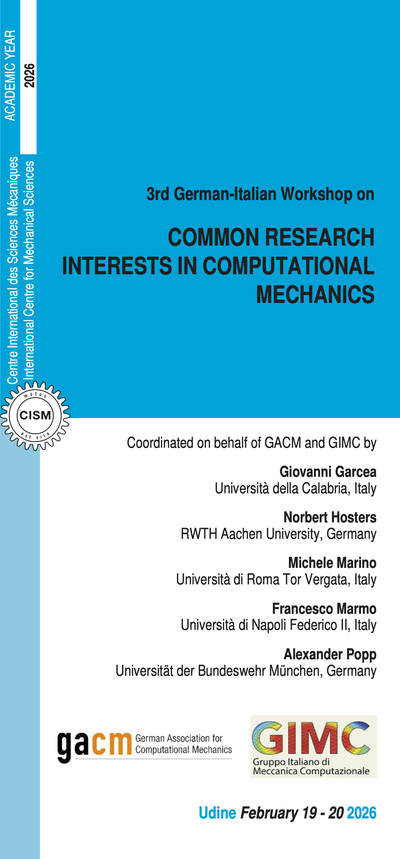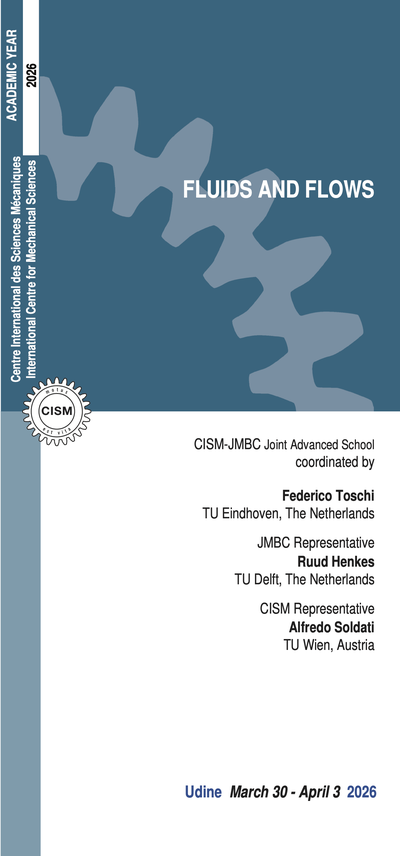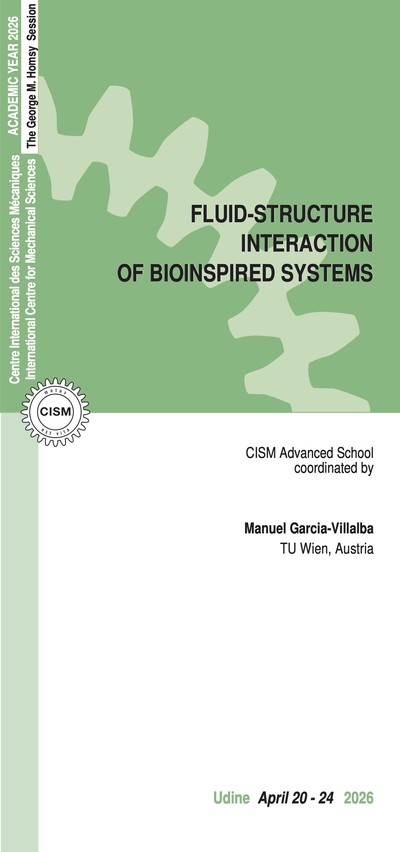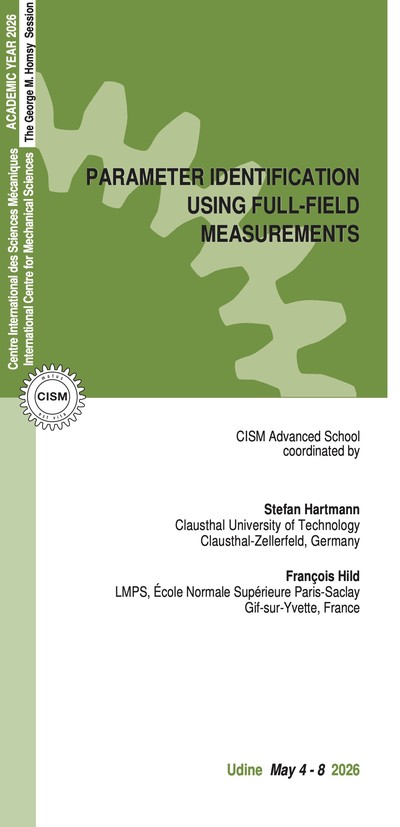Isogeometric analysis relies on the use of the same basis functions as employed in Computer Aided Design (CAD). This offers the possibility to facilitate design and optimisation. The previous course "Isogeometric methods for numerical simulation” held in 2013 had the aim to give an introduction to isogeometric analysis, its advantages, drawbacks and to the range of its applications. The aim of the proposed new course will be different. The focus will be more on the connection of simulation to CAD systems and how CAD data can be used directly for simulation, leading to a seamless integration. An overview of recent advances and applications will be also presented. The course will start with an introduction to NURBS and their use in describing geometry and in simulation. This will be followed by lectures from a CAD vendor describing the current state of development. Currently available connections to simulation software will also be discussed. Next the use of NURBS for 3D structural analysis, structural optimisation and damage tolerance assessment will be presented, including such advanced topics as the treatment of discontinuities and real-time solvers. It will also be discussed when it might be advantageous to decouple the boundary discretisation from the field variable discretisation, in particular in shape optimisation. Isogeometric methods for the analysis of beam and shell structures, including shape optimisation and fluid structure interaction, will be presented. Lectures on the mathematical and algorithmic foundations of analysis-suitable geometry will follow. This includes an introduction to T-splines and multilevel spline schemes such as hierarchical B- splines. Common analysis-suitable spline algorithms will be presented in the context of Bézier extraction and projection as well as its application as a foundation for integrated engineering design and analysis. An important aspect of analysis-suitable geometry is the ability to locally adapt the smooth spline basis. Several common refinement algorithms will be reviewed as well as their application in several demanding areas of application. The emerging area of weak geometry will be introduced as well as its application to the rapid construction of complex structural assemblies. With the rapid development of isogeometric analysis in recent years, there is an urgent need for volumetric parameterization such as volumetric T-spline model construction. Several volumetric T- spline modeling techniques, that were developed in recent years will be presented. They include converting any quad/ hex meshes to standard and rational T-splines, polycube-based parametric mapping, feature preservation using eigenfunctions, Boolean operations and skeletons, truncated hierarchical Catmull-Clark subdivision, weighted T-splines, conformal T-spline modeling, as well as incorporating T-splines into commercial CAD and FEA software, will be presented. The target audience will be engineers, interested in simulation, software developers and researchers.
G. Beer and S. Bordas, editors, "Isogeometric methods for numerical simulation", CISM lecture notes, Springer, 2015. G. Beer, "Advanced numerical simulation methods - From CAD Data directly to simulation results", CRC Press/Balkema, 2015. D. C. Thomas, M. A. Scott, J. A. Evans, K. Tew, E. J. Evans, “Bézier projection: a unified approach for local projection and quadrature-free refinement and coarsening of NURBS and T-splines with particular application to isogeometric design and analysis” Computer Methods in Applied Mechanics and Engineering, Vol. 284, 55–105, 2015. Y. Bazilevs, V. M. Calo, J. A. Cottrell, J. A. Evans, T. J. R. Hughes, S. Lipton, M. A. Scott, and T. W. Sederberg, “Isogeometric analysis using T-splines,” Computer Methods in Applied Mechanics and Engineering, Vol. 199, 229–263, 2010. M. J. Borden, M. A. Scott, J. A. Evans, and T. J. R. Hughes, “Isogeometric finite element data structures based on Bézier extraction of NURBS,” International Journal for Numerical Methods in Engineering, Vol. 87, 15–47, 2010. Nguyen, V. P., Anitescu, C., Bordas, S. P., & Rabczuk, T. (2015), "Isogeometric analysis: an overview and computer implementation aspects", Mathematics and Computers in Simulation, 117, 89-116. Y. Zhang, W. Wang, T. J. R. Hughes, "Conformal Solid T-spline Construction from Boundary T-spline Representations", Computational Mechanics, 51(6):1051-1059, 2013. X. Wei, Y. Zhang, T. J. R. Hughes, M. A. Scott, "Truncated Hierarchical Catmull-Clark Subdivision with Local Refinement", Computer Methods in Applied Mechanics and Engineering, 291:1-20, 2015. Y. J. Zhang, "Geometric Modeling and Mesh Generation from Scanned Images", Chapman & Hall/CRC Mathematical and Computational Imaging Sciences Series. CRC Press, Taylor & Francis Group. 2016.
Gernot Beer (None)
5 lectures on: Introduction to NURBS basis functions, geometry description, link to CAD, NURBS based simulation, the Boundary Element Method as ideal companion to CAD, Applications.Kai-Uwe Bletzinger (None)
6 lectures on:CAD-FEM Integration for shells, Trimming, IGA based optimization, Fluid structure interaction and surface coupled IGA models, Nonlinear IGA beams, Applications.Stéphane P.A. Bordas (None)
6 lectures on: A priori and a posteriori error estimation, enriched iso-geometric analysis for fracture, sub and super-geometric approaches. Partition of unity enrichment with a focus on discontinuities, singularities. Open Source implementation for 3D fracture.Giuseppe Massoni (None)
6 lectures on:Controlling shapes, geometrical and aesthetic language. The curve, surface, closed polysurface process and surfacing tools; best practice. "Implicit history" vs "explicit history". Parametric modeling with Grasshopper. Kangaroo: an interactive physics/constraint solver plugin for Grasshopper. Scan & Solve.Michael Scott (None)
6 lectures on: Introduction to fundamental concepts in analysis-suitable geometry, adaptivity, integration with analysis, and commercial application.Jessica Zhang (None)
6 lectures on:Discussion on several volumetric parameterization techniques, including converting quadrilateral/hexahedral meshes to T-splines; polycube-based parametric mapping; feature preservation; truncated hierarchical Catmull-Clark subdivision; weighted and truncated T-splines; conformal modeling; as well as broad applications in computational biomedicine and material sciences.The registration fee is 575.00 Euro + VAT taxes*, where applicable (bank charges are not included). The registration fee includes a complimentary bag, four fixed menu buffet lunches (on Friday upon request), hot beverages, downloadable lecture notes and wi-fi internet access. Applicants must apply at least one month before the beginning of the course. Application forms should be sent on-line through our web site: http://www.cism.it. A message of confirmation will be sent to accepted participants. If you need assistance for registration please contact our secretariat. Applicants may cancel their course registration and receive a full refund by notifying CISM Secretariat in writing (by email) no later than two weeks prior to the start of the course. If cancellation occurs less than two weeks prior to the start of the course, a Euro 50.00 handling fee will be charged. Incorrect payments are subject to Euro 50.00 handling fee. A limited number of participants from universities and research centres who are not supported by their own institutions can be offered board and/or lodging in a reasonably priced hotel or student dormitory, if available. Requests should be sent to CISM Secretariat byApril 5, 2017 along with the applicant's curriculum and a letter of recommendation by the head of the department or a supervisor confirming that the institute cannot provide funding. Preference will be given to applicants from countries that sponsor CISM. Information about travel and accommodation is available on our web site, or can be mailed upon request.
* Italian VAT is 22%.

